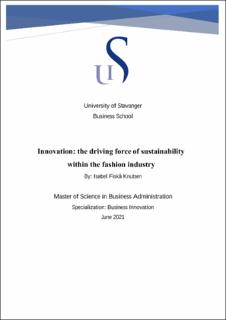| dc.description.abstract | Transparency has become one of the most prominent consumer demands, and research has shown that the concept of transparency can be an essential tool in product, process, and business model innovation. The fashion industry is linked to a lot of major environmental problems and is considered the second-worst polluting industry in the world. The growing focus on both sustainability and the effect of transparency has influenced the research question “How does the demand for transparency add pressure and advance innovation centered around sustainability?”
Added pressure has been put on the fashion industry, as the consumers are expressing their desire for sustainable fashion, showing willingness to pay more for sustainable clothes. In response, ethical production within the fashion industry has increased and numerous brands have developed policies, programs, and initiatives. Findings from The Fashion Transparency Index, such as a consistent improvement in most of the sections and increased focus on areas concerning sustainability, suggest that there is in fact a desire for being perceived as sustainable. However, not all numbers indicate a commitment to innovative activities related to sustainability. A lot of the major brands share more concerning their policies compared to how they actually apply these policies and the results they have achieved after implementation. Four different brands were presented through a comparative case study, where the focus on innovation activities related to sustainability was reviewed. All brands highlighted the importance of sustainability. The top-ranking brand showed a commitment to sustainability by heavily investing in innovation to further sustainability in the fashion industry, whereas the other brands essentially gave an impression of presenting a false image of being sustainable. Findings presented in the Fashion Transparency Index, such as the consumption area and the implementation, as well as the impression some of the brands gave, suggests that proper action towards sustainability has not been made. Instead, there has been an increase in the concept of greenwashing within the fashion industry. | |
